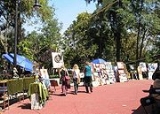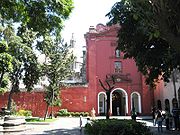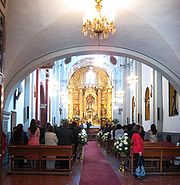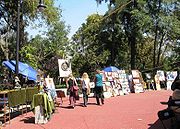
San Ángel
Encyclopedia

Colonia (Mexico)
In general, colonias are neighborhoods in Mexican cities, which have no jurisdictional autonomy or representation. It is plausible that the name, which literally means colony, arose in the late 19th, early 20th centuries, when one of the first urban developments outside Mexico City's core was...
of Mexico City
Mexico City
Mexico City is the Federal District , capital of Mexico and seat of the federal powers of the Mexican Union. It is a federal entity within Mexico which is not part of any one of the 31 Mexican states but belongs to the federation as a whole...
, located in the southwest in Álvaro Óbregon borough
Álvaro Obregón, D.F.
Álvaro Obregón is one of the 16 delegaciones into which Mexico's Federal District is divided. It contains a large portion of the south-west part of Mexico City. It had a 2010 census population of 727,034 inhabitants and lies at an elevation of 2,319 m...
. Historically, it was a rural community, called Tenanitla in the pre Hispanic period. Its current name is derived from the El Carmen monastery school called San Ángel Mártir. San Ángel remained a rural community, centered on the monastery until the 19th and 20th centuries, when the monastery was closed and when the area joined urban sprawl of Mexico City. However, the area still contains many of its former historic buildings and El Carmen is one of the most visited museums in the city. It is also home to an annual flower fair called the Feria de las Flores.
Geography
San Ángel is located in the southwest of the Federal District of Mexico along the southern end of Avenida Insurgentes, bordering the Ciudad UniversitariaCiudad Universitaria
Ciudad Universitaria , Mexico, is UNAM's main campus, located in Coyoacán borough in the southern part of Mexico City. Designed by architects Mario Pani and Enrique del Moral, it encloses the Olympic Stadium, about 40 faculties and institutes, the Cultural Center, an ecological reserve, the Central...
of UNAM
Unam
UNAM or UNaM may refer to:* National University of Misiones, a National University in Posadas, Argentina*National Autonomous University of Mexico , the large public autonomous university based in Mexico City...
. For most of its history, the area was politically and physically separate from the urban sprawl of Mexico City, becoming part of it around the mid 20th century.
The community is surrounded by a volcanic rock bed called the Pedregal, which was formed by the eruption of nearby Xitle Volcano
Xitle
Xitle is a volcano in the Ajusco range in Cumbres del Ajusco National Park. It is located in the Tlalpan borough in the southwestern part of Mexico City. It is an ash cone volcano with a conical form, round base, altitude of approximately 300m, and a slope between 30° and 40°.Xitle registered its...
about two thousand years ago. Parts of this volcanic rock bed have been made into protected areas such as the Pedregal de San Ángel. This area is estimated to have a total of 350 native veined plant species, 100 species of birds, forty species of mammals and twenty of reptiles. The representative plant of the area is called the palo loco (crazy stick) because it blooms in the dry season rather than the rainy season.
El Carmen complex

The church was built between 1624 and 1626 also dedicated to San Ángel Martír. The facade is Herrerian
Herrerian
The Herrerian was developed in Spain during the last third of the 16th century under the reign of Philip II , and continued in force in the 17th century, but transformed by the Baroque current of the time...
over which is its bell-gable
Bell-gable
The bell gable is an architectural element crowning at the upper end of the wall of church buildings, usually in lieu of a church tower. It consists of a gable end in stone, with small hollow semi-circular arches where the church bells are placed...
, modeled after that of San José de Ávila
Convento de San José (Ávila)
The Convento de San José is a monastery of Discalced Carmelite nun in Ávila, Spain. It is situated not far from the center of the city but outside the medieval walls. Saint Teresa of Avila was the driving force behind the foundation of the monastery, which was built from 1562 onwards...
in Spain
Spain
Spain , officially the Kingdom of Spain languages]] under the European Charter for Regional or Minority Languages. In each of these, Spain's official name is as follows:;;;;;;), is a country and member state of the European Union located in southwestern Europe on the Iberian Peninsula...
. The structure is topped by three domes covered in glazed tile. The entire monastery complex was complete in 1628. It was surrounded by large tracts of gardens and orchards, much of which is now Colonia Chimalistac to the east. These orchards made the monastery wealthy and famous.
The monastery and school area came under the custody of the Instituto Nacional de Antropología e Historia in 1939 which still maintains it. The current museum was opened in 1955 and is one of the most visited in the city. The museum conserves a number of the monastery’s original spaces, such as the dining room, and has one of the most important collections of colonial era art in Mexico, including a permanent exhibition called “The Silence of the Carmelites.” This traces the history of the order from its origins through images, sculpture, documents, furniture and more.
One reason the museum is well-visited is the mummies on display in the basement crypt area. From the 17th to the 19th centuries, one way that the order raised funds for its existence was to set aside crypts for donors from the wealthy families of the area. While many of these bodies would be exhumed after a number of years, with their bones stored in an "osorio" later, some of the interred here did not completely decompose. Between 1917 and 1918, troops ransacked the convent, looking for treasure. What they found in the crypt area instead were a number of well-preserved, naturally occurring mummies. The museum has twelve mummies on display in the crypt area, however, many are in deteriorating condition because they are not in hermetically sealed cases.
Other landmarks
Around the Plaza del Carmen, there are a number of historic buildings such as the old municipal palace, which has been converted into the Centro Cultural San Ángel. Near this are two former mansions which belonged to the Mariscal de Castilla. More of the area’s mansions are found on La Amargura Street including one that belonged to the Fagoaga family. This structure dates from the 18th century and belonged to Francisco Fagoaga, who ran the colonial coin mintMuseo Nacional de las Culturas
The Museo Nacional de las Culturas is a national museum in Mexico City dedicated to education about the world's cultures, both past and present. It is housed in a colonial-era building that used to be the mint for making coins...
. It is said that it was also inhabited by Archbishop Alonso Núñez de Haro y Peralta
Alonso Núñez de Haro y Peralta
Dr. Alonso Núñez de Haro y Peralta was archbishop of Mexico from September 12, 1772 to May 26, 1800, and viceroy of New Spain from May 8, 1787 to August 16, 1787.-Origins and education:Núñez de Haro was born in the diocese of Cuenca, Spain, probably on October 31, 1729, although some...
. Another house on this street was the property of Porfirio Díaz
Porfirio Díaz
José de la Cruz Porfirio Díaz Mori was a Mexican-American War volunteer and French intervention hero, an accomplished general and the President of Mexico continuously from 1876 to 1911, with the exception of a brief term in 1876 when he left Juan N...
. The Casa del Obispo Madrid, in contrast, is a simple adobe
Adobe
Adobe is a natural building material made from sand, clay, water, and some kind of fibrous or organic material , which the builders shape into bricks using frames and dry in the sun. Adobe buildings are similar to cob and mudbrick buildings. Adobe structures are extremely durable, and account for...
structure from 1631, which was the property of Bishop Fernandez de Madrid. Later, it was inhabited by General Santa Anna and poet José Zorrilla.


Saint Hyacinth
Saint Hyacinth, O.P., was educated in Paris and Bologna. A Doctor of Sacred Studies and a secular priest, he worked to reform women's monasteries in his native Poland...
. Its main altar is wood covered in gold. The former monastery is austere and served as such until 1754.
The Plazuela de los Licenciados is on Calle de Juárez with three notable residences. One is in European style, another is from the 18th century and the last was the former Hospital Real de Naturales. A short distance from this plaza is another structure called the Casa Blanca which is possibly the oldest in San Angel, built in the middle of the 17th century by the Counts of Oploca. Its orchards were second only to those of El Carmen.
The Plaza de Arcangeles is small and not well known but it is distinct in its abundance of trees and other vegetation. Its name comes from three large sandstone benches with the name of the Archangels Gabriel, Michael and Rafael on them.
The Museo Casa Estudio Diego Rivera y Frida Kahlo is on Altavista and Diego Rivera Streets. These were dual houses, one for each painter, connected which served as homes and work spaces for the pair. The structure was built by Juan O´Gorman as one of the first Functionalist structures in Mexico City. The museum has a notable collection of Judas figures
Burning of Judas
The burning of Judas is an Easter-time ritual in many Orthodox and Catholic Christian communities, where an effigy of Judas Iscariot is burned. Other related mistreatment of Judas effigies include hanging, flogging, and exploding with fireworks. Anthropologists generalize these type of activities...
made of paper and cardboard and burnt on Holy Saturday
Holy Saturday
Holy Saturday , sometimes known as Easter Eve or Black Saturday, is the day after Good Friday. It is the day before Easter and the last day of Holy Week in which Christians prepare for Easter...
.
The Museo de Arte Carrillo Gil is on Camino al Desierto de los Leones, which has one of the country’s best contemporary art collections. It also is a research and support center for artists.
The Pedregal de San Angel Ecological Reserve is located in the southwest of Mexico City in the Ciudad Universitaria
Ciudad Universitaria
Ciudad Universitaria , Mexico, is UNAM's main campus, located in Coyoacán borough in the southern part of Mexico City. Designed by architects Mario Pani and Enrique del Moral, it encloses the Olympic Stadium, about 40 faculties and institutes, the Cultural Center, an ecological reserve, the Central...
. It is one of the few undisturbed natural ecosystems in the Valley of Mexico. It is distinguished as being over a relatively solid bed of volcanic rock, from an eruption of the nearby volcano Xitle and has a number of unique plant and animal species.
History
The San Angel area was originally called Tenanitla, which means “walled in place” in Nahuatl. This referred to the solidified volcanic flow that surrounds the center of San Angel, which came from the nearby Xitle Volcano about 2,000 years ago.The modern community has its roots in the establishment of who monastery complexes called San Jacinto and El Carmen in the 16th century, but the real center would be El Carmen. The Spanish town here was originally established with the name of San Jacinto Tenanitla. El Carmen was begun in 1597 when in the indigenous leader of Coyoacán
Coyoacán
Coyoacán refers to one of the sixteen boroughs of the Federal District of Mexico City as well as the former village which is now the borough’s “historic center.” The name comes from Nahuatl and most likely means “place of coyotes,” when the Aztecs named a pre-Hispanic village on the southern shore...
, Felipe de Guzmán Itzolinque along with Andrés de Mondragón and Elvira Gutierrez donated lands to the Carmelites
Carmelites
The Order of the Brothers of Our Lady of Mount Carmel or Carmelites is a Catholic religious order perhaps founded in the 12th century on Mount Carmel, hence its name. However, historical records about its origin remain uncertain...
in the Tenanitla and Chimalistac areas. The monks used the land to establish their monastery and a school for monks, with the school, named San Angel, inaugurated in 1613. The monastery and school became wealthy and powerful, mostly due to the productively of the lands, especially the orchards which had, at one time, over 13,000 trees. This prompted the community to rename itself San Angel.
The monastery complex remained important through the colonial period, but a series of misfortunes would lead to its closure by the end of the 19th century. Shortly after Independence, the complex lost many of its monks, who were Spanish born. It was the site of a struggle called the Guerra de las Patentes (War of the Patents) over the payment of rental fees for farmland belonging to the monastery, which the monastery lost. During the Mexican American War, U.S. troops sacked and destroyed some of its buildings and orchards and in 1856, the institution had to begin to partition and sell some of its lands. The monastery was closed as such during the Reform War, with only the church portion remaining completely intact.
The school portion, called the Colegio, was disputed between the municipal governments of Mexico City and San Angel, which were separate at that time. The dispute was settled in San Angel’s favor in 1874 by Manuel Payno. However, parts of the school would be destroyed in 1891 to make way for the railroad connecting Mexico City to Tizapán. What remained became the property of the Secretaría de Educación Pública in 1921. In 1939, it would come under the custody of INAH and in the 1950s, it was converted into a museum.
The rest of San Angel remained a rural farm community. The first change came in the second half of the 18th century, when wealthy families, such as that of the First Count of Revillagigedo, began to build country homes here. Through the 19th century, the area remained rural and popular for visitors. San Angel from this time period was described by traveler Marquesa Calderón de la Barca in her book La vida en México.
At the end of the 19th century, a number of factories were set up here such as Loreto, La Alpina and La Hormiga, which raised the area’s population. This was the beginning of the urbanization of San Angel, although it would remain physically separate from the rest of urbanized Mexico City until the mid 20th century. Much of the area was not considered suitable for mass development until the 1950s, when the Ciudad Universitaria was constructed. The two growing areas would eventually join, completed with the construction of Avenida Insurgentes which divided the former gardens of El Carmen from those of Chimalistac. The construction of Avenida Revolución would then divide San Angel into two parts.
The Pedregal de San Angel was declared and ecological reserve in 1983.
Since the 20th century, development pressures have increased, with many residential buildings being converted into commercial areas. To work to preserve the area’s rural layout and historic buildings, San Angel was made the city’s first Patrimonial Cultural Tangible de la Ciudad de México (Tangible Cultural Heritage of Mexico City) in 2008. It was also designated as a "Barrio Mágico"
Barrios Mágicos of Mexico City
The “Barrios Mágicos” of Mexico City is a list of twenty one areas in the Federal District, which have been named “magical neighborhoods” in order to attract tourism to them. The program is sponsored by the city government but is patterned after the “Pueblos Mágicos” program of the Mexican...
by the city in 2011.
Feria de las Flores
The main annual event for San Angel is the Feria de las Flores or Flower Fair, which takes place in July. This event has its origins in the pre Hispanic period as an event dedicated to Xiuhtecuitl, a god of flowers. The purpose of the original event was to seek the god’s protection for the area’s floral and fruit crops. When the Carmelites come to the area, they adapted the ritual to Our Lady of Mount Carmen, making her the patroness of the area. This resulted in a festival with both indigenous and Catholic elements. The modern version of the festival began in the late 19th century. Although the religious event continued through the colonial period, its popularity had waned. In 1885, an effort was made to rescue the tradition, having two events, one dedicated to the Our Lady of Mount Carmen and the other to Xiuhtecuitl. These were fused in 1940 by borough authorities with the name la Feria de las Flores de San Ángel. Since then, the event has become more secular. It begin with a parade of floats starting at the Parque de la Bombilla, and includes activities such as painting exhibitions and contests, concerts, dance and theater recitals, charreadaCharreada
The charreada or charrería is a competitive event similar to rodeo and was developed from animal husbandry practices used on the haciendas of Old Mexico. The sport has been described as "living history," or as an art form drawn the demands of working life...
and food tasting.

